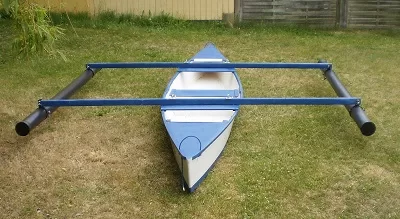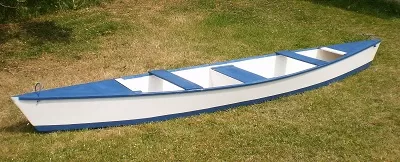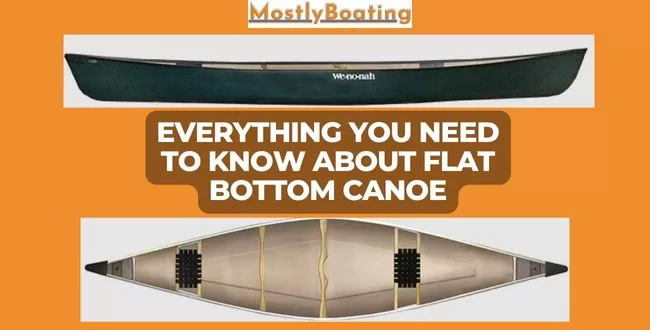Welcome aboard, water wanderers! Today, we are diving into the world of flat-bottom canoes – those sleek, stable, and surprisingly elegant wonders of the water.
A flat bottom canoe has a flat bottom that provides stability and ease of paddling in calm water and is popular for recreational use.
We will discuss multiple things related to the flat canoe, like characteristics, design, uses, differences, and even how to choose the right one for yourself.
Whether you are a seasoned paddler or just starting to dip your toes into canoeing, the flat-bottom canoe promises an adventure like no other.
Key Takeaways About Flat Bottom Canoe
How a flat canoe differs from other canoes (apart from flat bottom) – Flat-bottom canoes offer primary stability on calm water but sacrifice secondary stability. They have a flat hull shape, making them less maneuverable in rough water than other canoe designs.
What’s the use of flat bottom canoe- Flat-bottom canoes are used for recreational paddling, fishing, cottage use, and shallow water use.
Can a beginner use a flat canoe – Yes, beginners can easily use flat-bottom canoes due to their excellent initial stability in calm water.
What is a Flat Bottom Canoe?
A flat-bottom canoe is a type of canoe that has a flat, horizontal bottom surface. It offers great primary stability and is well-suited for calm waters which makes it suitable for beginners.
However, flat-bottom canoes sacrifice speed and performance in rough water or when leaned over to one side.
Historical Background
Cultures worldwide have developed canoes, with some designed for use with sails or outriggers.
Until the mid-19th century, canoes were important means of canoe transportation for exploration and trade.

Flat-bottom canoes were traditionally built in wood, such as the design developed in 1971 for operations in the Ivory Coast.
Flat-bottom canoes have been used for fishing, transportation, and recreational purposes for a long time.
Stability of Canoe Flat Bottom
Effect on Primary Stability
A flat-bottom canoe has good initial stability. This means it feels steady when upright on calm water, and paddlers experience little oscillation. The flatness of the bottom provides a wide base of support, making the canoe stable in calm conditions.
The greatest possible width of the hull is in the water, which contributes to the canoe’s stability.
When loaded, a flat-bottom canoe rides lower in the water but maintains stability if it remains upright in calm water.
Effect on Secondary Stability
Flat-bottom canoes have low final stability. Final stability refers to the resistance of a canoe to capsizing, even when on edge. Once the initial stability of a flat-bottom canoe is breached, it becomes difficult to avoid capsizing.
Flat-bottom canoes are vulnerable to wind, waves, and leaning. When the canoe leans, one side of the hull lifts entirely out of the water, reducing the submerged surface area and making it more prone to tipping over.
The flatness of the bottom compromises the secondary stability of the canoe. Secondary stability refers to the ability of a canoe to remain stable when leaned or in rough conditions like whitewater canoeing. Flat-bottom canoes are less predictable and responsive when leaned or on waves.
Characteristics of Flat Bottom Canoe
Hull Design
Flat canoes have a flat, horizontal bottom surface that provides good stability on calm water but is less stable in rough water or when leaned over to one side.
Stability
Flat-bottom canoes offer excellent firmness in the water, making them suitable for beginners and calm water paddling.
Dimensions
The length and width of a flat-bottom canoe can vary, with longer canoes offering better tracking and canoeing speed while wider canoes provide more stability.
Material Used
Flat-bottom canoes can be constructed using various canoe materials, such as wood, aluminum, or composite materials.
Weight Capacity
The weight capacity of a flat-bottom canoe depends on its size, construction, and design. Generally, flat-bottom canoes have good weight-carrying capacity.
Structure/Design of Flat Bottom Canoe
Hull Design
A flat-bottom canoe has a flat-bottom hull. The flatter the bottom, the more primary stability the canoe has, but the hull speed is reduced.

The cross-section shape of the hull determines both the strength and balance. A moderately rounded bottom is more maneuverable and capable of better speed, making it suitable for touring, canoe camping and expedition canoe hulls.
Stability
Flat-bottom canoes offer good primary stability but have low final stability, making them less predictable and responsive when leaned or on waves.
The flatness of the bottom provides a wide base of support, making the canoe stable in calm conditions.
It is important to maintain balance and caution when using a flat-bottom canoe, especially in rough water or when leaning.
Dimensions
The depth of a canoe affects its carrying capacity and freeboard, allowing the canoe to paddle through waves more easily. However, it can also make the canoe heavier and less responsive to wind.
The width between the gunwales is less than the canoe’s width, known as a tumblehome.
Tumblehome allows the canoe to be paddled without giving up hull displacement, determining weight-carrying capacity. The greater the displacement, the greater the carrying capacity.
Material Used
Flat-bottom canoes can be made from various materials, including aluminum, fiberglass, and Royalex.
- Aluminum canoes are lightweight, durable, and affordable but can be noisy and conduct heat and cold.
- Fibreglass canoes are lightweight, rigid, and provide good performance on the water, but can be more expensive and require more maintenance.
- Royalex canoes are lightweight, durable, and offer good impact resistance, but they are no longer manufactured.
Weight Capacity
The average weight capacity of a flat-bottom canoe ranges from 400 to 600 pounds but can vary depending on the width and length of the canoe.
For example, a 16-foot, 2-person recreational canoe can hold up to 940 pounds, a 14-foot canoe can hold about 700 pounds, and a 17-foot canoe can hold more than 1160 pounds.
Canoes with a greater displacement have a higher weight-carrying capacity. Considering the weight capacity when choosing a canoe for specific purposes such as fishing, camping, canoe accessories or carrying gear is important.
It is recommended to stay away from the maximum weight capacity by approximately 20% to avoid swamping or sinking the canoe.


Rocker
Rocker is the curvature of the hull from bow to stern. It determines how much the canoe’s ends rise above the hull’s bottom center.
Flat-bottom canoes typically have minimal rocker, meaning they have little curvature. This allows for better tracking in calm water but may reduce maneuverability in tight turns. Rocker can vary in three primary ways:
- The overall height of the bow or stern.
- How close to the center of the boat rocker starts?
- The shape of the rocker.
Straight Sides
Straight sides refer to the vertical rise of the canoe’s sides from the waterline. Flat-bottom canoes often have straight sides, which provide additional stability and allow for more efficient use of interior space.
What are the uses of Flat Bottom Canoe?
- Fishing: Fishing uses flat-bottom canoes due to their exceptional stability and efficiency, making casting and reeling fish easier.
- Recreational paddling: Flat-bottom canoes are easy to paddle and offer good primary stability, making them popular for recreational paddling in calm waters.
- Family outings: Flat-bottom canoes are stable and easy to maneuver, making them a good choice for family outings and beginner paddlers.
- Camping: Flat-bottom canoes have good carrying capacity and are suitable for carrying gear and supplies for camping trips.
- Wildlife observation: Flat-bottom canoes are quiet and stable, making them ideal for observing wildlife in calm waters.
- Whitewater paddling: Flat-bottom canoes with a shallow arch hull are suitable for paddling in whitewater and rugged conditions.
Advantages & Disadvantages of Flat Bottom Canoe
Advantages of Flat Bottom Canoe:
Uniform water displacement: The flat bottom of a canoe displaces water uniformly, making a uniform hole on it with no side higher than the other, which makes it easier to paddle in a straight line.
Easy to maneuver: The flat shape of the hull allows for easy maneuverability in shallow water and tight spaces.
Versatile: Flat-bottom canoes can be used for various purposes, including recreational paddling, fishing, and cottage use.
Disadvantages of Flat Canoe:
Vulnerable to wind and waves: Flat-bottom canoes are vulnerable to wind and waves, making them less stable than others in rough water or when leaned over to one side.
Less efficient: The flat shape of the hull can make flat bottom canoes less efficient than other types of canoes, especially in rough water or when paddling against the wind.
Less maneuverable: Flat-bottom canoes may be less maneuverable than other canoes, especially in tight turns or when navigating obstacles.
How do I Choose the Right Flat Bottom Canoe?
Consider Your Paddling Plans:
Flat-bottom canoes are good for use in calm waters. So if you plan to paddle in calm waters for recreational paddling or fishing, it is the best for you.
Length and Width:
Flat-bottom canoes’ length and width are best for stability and agility and have enough cargo space.
Longer canoes generally move faster through the water and have greater carrying capacity, while shorter canoes tend to be more maneuverable and lighter. Wider canoes provide more stability, while narrower canoes are faster and more efficient.
Hull Shape:
Flat-bottom canoes offer good initial stability in calm water, making them a good choice for beginners and use in calm conditions. Canoes with different hull designs, such as rounded or V-shaped hulls, may offer better stability and control in these situations.
Materials:
Flat-bottom canoes can be constructed using various materials, such as wood, aluminum, or composite materials. The choice of materials affects the canoe’s weight, durability, and cost.
Try Before You Buy:
Try a canoe before buying it. This can help you understand the canoe’s stability, maneuverability, and overall performance.
Weight Capacity:
Consider the weight capacity of the canoe. This depends on its size, construction, and design. Generally, flat-bottom canoes have good weight-carrying capacity.
Paddling a Flat Bottom Canoe – Is it different?
Paddling a flat-bottom canoe is similar to paddling other canoes, but there are some differences to remember. It is different in such a way that paddling in a flat-bottom canoe has more stability and agility in it. But there are slower than other canoes.
Basic Paddling Strokes
Forward Stroke: Reach forward with the paddle blade and pull it back through the water, keeping the blade vertical and close to the canoe.
Backward Stroke: Reach backward with the paddle blade and push it forward through the water, keeping the blade vertical and close to the canoe.
J-Stroke: This stroke is used to keep the canoe moving straight. After the forward stroke, turn the paddle blade outward and pull it back towards the canoe’s stern in a J-shaped motion. This will help correct the canoe’s tendency to turn to one side.
Turning and Maneuvering Tips
Sweep Stroke: The canoe is turned with this stroke. The paddle blade should be extended to the side of the canoe and swept in a broad arc towards the canoe’s stern.
Draw Stroke: This stroke is used to move the canoe sideways. Reach out to the side of the canoe with the paddle blade and pull it towards the canoe.
Cross-Bow Draw Stroke: This stroke is used to turn the canoe quickly. Reach out to the side of the canoe with the paddle blade and pull it towards the bow of the canoe while pushing the opposite end of the paddle away from the canoe.
Dealing with Crosswinds
Crouch Low: Crouch as low as you can comfortably paddle. This lowers your centre of gravity and helps to maintain stability in windy conditions.
Heel the Canoe: Heel the canoe away from the wind. By leaning the canoe into the wind, you allow it to blow over the curve of the hull, reducing the chance of being pushed off course.
Trim the Canoe: Adjust the trim by shifting the weight forward or backward. In strong tailwinds, trim the canoe slightly stern down. In headwinds, trim the canoe slightly and bow down. This helps to maintain balance and control in varying wind conditions.
Use a J-Stroke: The J-stroke involves turning the paddle blade outward and pulling it back towards the canoe’s stern in a J-shaped motion. This corrective stroke helps counteract the canoe’s tendency to turn to one side in crosswinds.
Handling Different Water Conditions
Flat-bottom canoes are vulnerable to wind and waves, so caution’s important. Flat-bottom canoes offer stability and are suitable for recreational paddling in calm water. In rough water or when leaned over to one side, flat-bottom canoes may be less stable than other types of canoes.
Popular Models and Brands
- Old Town Guide 119: This is a popular solo paddling and fishing model. It is lightweight and easy to maneuver, with a flat bottom design that provides great stability in calm water.
- Pelican Explorer 14.6 DLX: This versatile canoe with a flat bottom design offers good stability and cargo space. It is easy to paddle and maintain, making it a popular choice for recreational use.
- Grumman Sport Boat: This durable and versatile canoe can be used for fishing, hunting, or recreational paddling. It has a flat bottom design that provides great stability and cargo space.
- Coleman Ram-X: This is a budget-friendly option for recreational paddling. It has a flat bottom design that offers good stability and maneuverability, although it may not be as durable as other models.
Flat Bottom Canoe vs. Other Canoe Types
Flat Bottom vs. Rounded Hull
A flat-bottom canoe offers the best primary stability on calm water, while a rounded hull offers less stability but is swifter.
A canoe with a flat bottom will feel very stable initially, but when leaned or in waves, it will begin to feel very unstable quite quickly.
A canoe with a shallow arch hull is widest just above the waterline, which makes it more stable when loaded.
Flat Bottom vs. V-Shaped Hull
A V-shaped hull is designed for speed and efficiency, while a flat-bottom canoe is not.
A flat-bottom canoe is excellent for shallow water use and offers superior stability in calm water, while a V-shaped hull is less stable but faster.
Flat Bottom vs. Multi-Chine Hull
A multi-chine hull has multiple flat sections on the bottom, which provides more stability than a V-shaped hull but less than a flat-bottom canoe.
A flat-bottomed canoe is optimal for main stability on calm water, while a multi-chine hull provides more stability than a V-shaped hull but less than a flat-bottom canoe.
Where & When not to use a flat bottom canoe?
- Rough Water:
Flat-bottom canoes are not as stable in rough water. The lack of secondary stability can make it difficult to maintain balance and control in choppy or wavy conditions.
In these situations, a canoe with a different hull design, such as a round-bottom canoe, may provide better stability and maneuverability.
- Leaning:
Flat-bottom canoes are less stable when leaned over to one side. If you anticipate the need to lean or tilt the canoe for maneuvers or to navigate obstacles, a canoe with a different hull shape, such as a vee or round bottom, may offer better stability and control.
- Wind:
Flat-bottom canoes are vulnerable to wind. The flat shape of the bottom can make it more difficult to paddle against strong winds, as the canoe may be more prone to being pushed off course.
In windy conditions, a canoe with a different hull design, such as a canoe keel or a rounded bottom, may provide better tracking and stability.
FAQs – All About Flat Canoe
Flat Bottom Canoes are good for beginners or not?
Flat-bottom canoes are good for beginners because they offer excellent reliability and durability in calm water, making them easy to maneuver and suitable for novice paddlers. However, they may be less stable in rough water or when leaned over to one side.
Which canoes are used in International canoeing competitions?
Yes, there are several canoe types like solo/tandem which are used in international canoeing competitions. They are used in canoe sprints and canoe slaloms.
Is a flat-bottom canoe beneficial for fishing?
Yes, flat-bottom canoes are beneficial for fishing. They offer excellent stability in calm water, making them easy to maneuver and suitable for novice paddlers. Their flat shape also provides a stable platform for casting and reeling fish.
Is a flat bottom design suitable for carrying heavy loads?
Yes, a flat bottom design is suitable for carrying heavy loads due to its excellent primary stability and buoyancy.
The flat shape of the hull provides a stable platform for carrying gear and equipment. However, it’s important to note that flat-bottom canoes may be less stable in rough water or when leaned over to one side.
Are flat canoes cheap as compared to normal canoes?
On average, flat-bottom canoes may or may not be cheaper than other canoes. The cost of a canoe depends on various factors, such as size, materials, and construction.

Passionate freelance writer and certified boat captain, Sam brings his expertise to this pedal boating & Canoeing blog. With a knack for captivating storytelling and in-depth knowledge of boating regulations, he’s here to make your boating experience even more enjoyable and informed.
